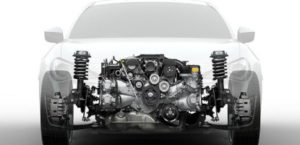In 2007, mainly for Infiniti cars, the most advanced engine from the VQ series was introduced, designated as VQ37VHR. This unit replaced the VQ35HR and was developed on its basis. The block of cylinders VQ35HR has grown slightly in height, along with this, its rigidity has been increased. A crankshaft with a piston stroke of 86 mm, long connecting rods, light pistons with a Compression ratio of 11. This made it possible to increase the working volume from 3.5 liters to 3.7 liters.
The 3.7-liter V6 Nissan VQ37VHR engine (or VQ37 for short) is assembled at the company’s Iwaki plant and installed on many well-known models of the Japanese concern on the Front Midship platform. At the moment, such a power unit is installed only on the Fuga sedan and 370Z coupe.
The VQ30 series also includes internal combustion engines: VQ30DE, VQ30DET, VQ30DD, VQ35DE, VQ35DD and VQ35HR.
The engine was installed on:
- Infiniti G37 V36, Q40 1 (V36), Q50 1 (V37), Q60 1 (CV36), M37 4 (Y51), Q70 1 (Y51), EX37 1 (J50), QX50 1 (J50), FX37 2 (S51), QX70 1 (S51);
- Nissan 370Z 6 (Z34), Fuga 2 (Y51), Skyline 12 (V36);
- Mitsubishi Proudia 2 (BY51).
Specifications
| Manufacturer | Iwaki Plant |
| Also called | VQ37 |
| Production years | 2007 |
| Cylinder block alloy | aluminum |
| Fuel system | injector |
| Configuration | V6 |
| Valves per cylinder | 4 |
| Piston stroke, mm | 86 |
| Cylinder bore, mm | 95.5 |
| Compression ratio | 11.0 |
| Displacement, cc | 3696 |
| Power output, hp | 330/7000 333/7000 355/7000 |
| Torque output, Nm / rpm | 361/5200 363/5200 365/5200 |
| Fuel type | petrol |
| Euro standards | Euro 4/5 |
| Weight, kg | 210 |
| Fuel consumption, L/100 km (for Q70) — city — highway — combined |
15.3 8.4 10.9 |
| Oil consumption, gr/1000 km | up to 500 |
| Recommended engine oil | 0W-30 / 0W-40 / 5W-30 / 5W-40 / 10W-30 / 10W-40 / 15W-40 |
| Engine oil capacity, liter | 5.4 |
| Oil change interval, km | 15000 |
| Engine lifespan, km | ~250 000 |
Disadvantages of the VQ37VHR engine
- The bulk of the complaints on the forums are related to oil consumption and there are several reasons for this: firstly, this is the natural wear of the unit due to overly aggressive operation, and secondly, the catalysts here are afraid of bad fuel and break down rather quickly, and their crumbs are drawn into the combustion chambers where they scratch the walls and form scuff marks.
- Another known problem is the oil passages under the front cover. Until 2012, they were made from paper, which was often squeezed out already by 100,000 km. All this is fraught with leaks, a drop in lubricant pressure in the unit and rotation of the liners.
- With active driving, this motor is very hot and it is important to monitor the cooling system. And not only periodically wash the radiators, but also change the cap of the expansion tank. There are no hydraulic lifters here, so do not forget about adjusting valve clearances.






